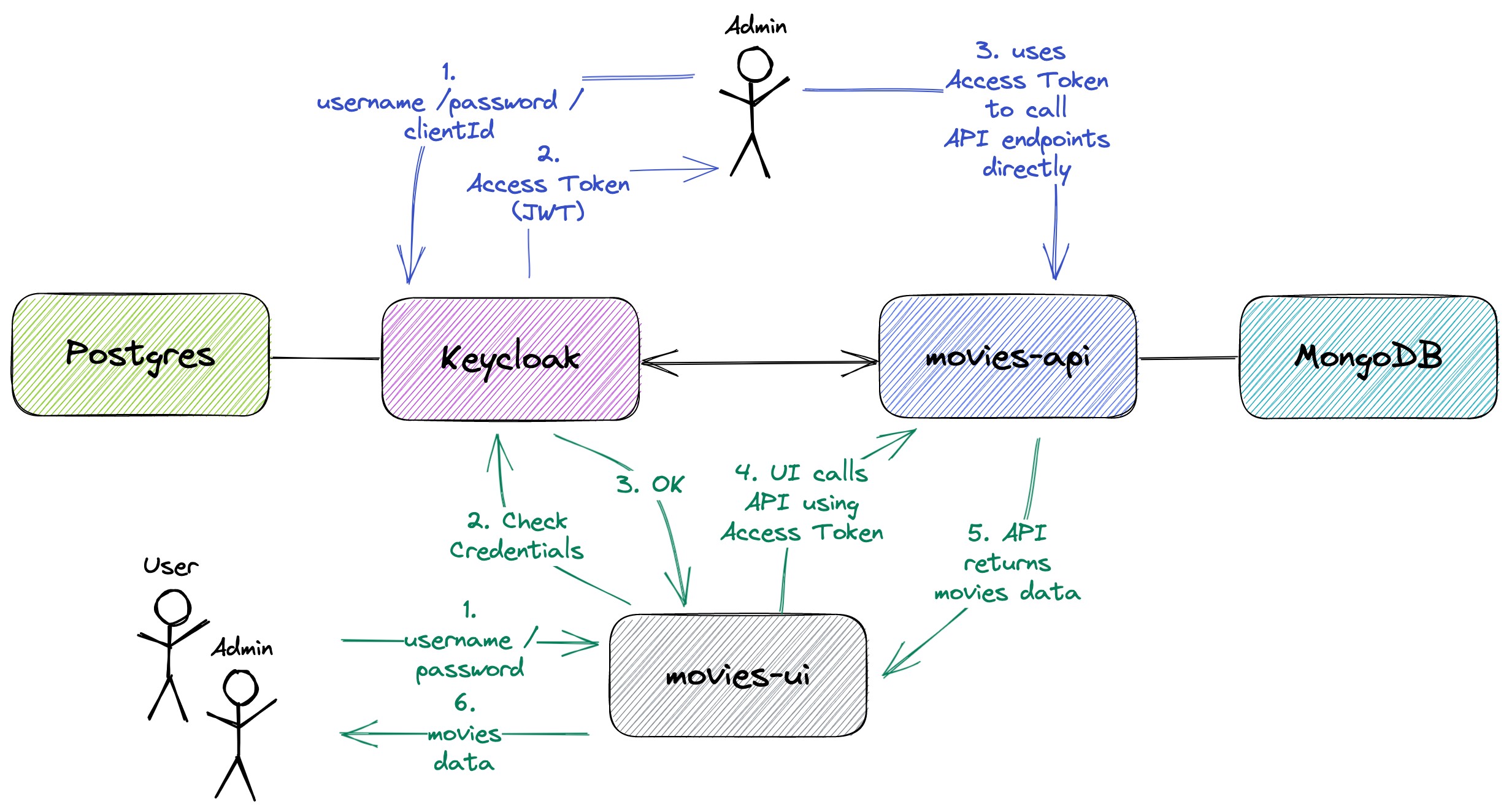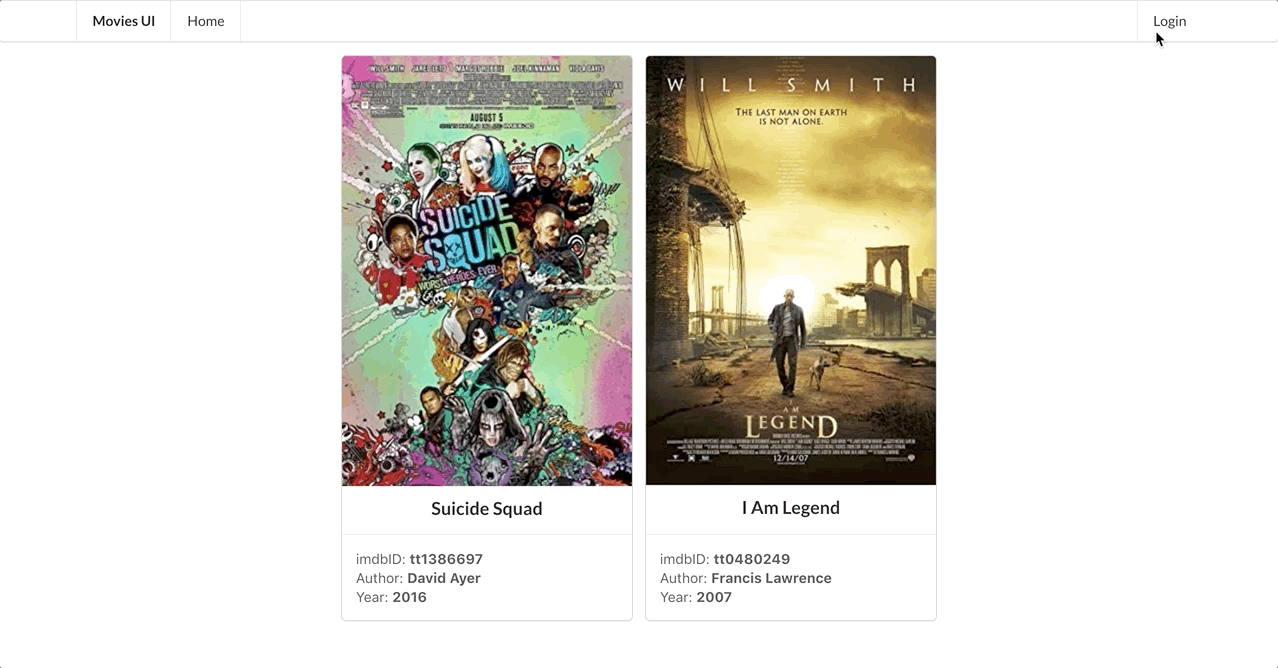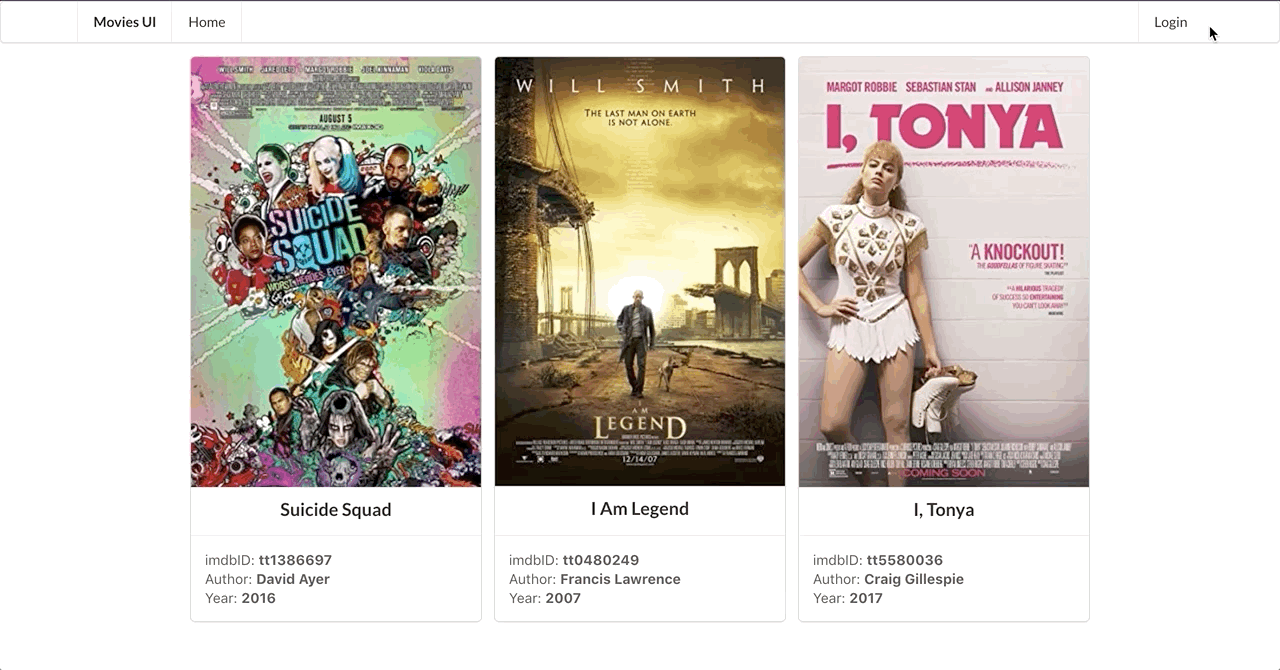The goal of this project is to secure movies-app using Keycloak(with PKCE). movies-app consists of two applications: one is a Spring Boot Rest API called movies-api and another is a React application called movies-ui.
On ivangfr.github.io, I have compiled my Proof-of-Concepts (PoCs) and articles. You can easily search for the technology you are interested in by using the filter. Who knows, perhaps I have already implemented a PoC or written an article about what you are looking for.
- [Medium] Implementing a Full Stack Web App using Spring-Boot and React
- [Medium] Using Keycloak to secure a Full Stack Web App implemented with Spring-Boot and React
- [Medium] Implementing and Securing a Simple Spring Boot REST API with Keycloak
- [Medium] Implementing and Securing a Simple Spring Boot UI (Thymeleaf + RBAC) with Keycloak
- [Medium] Implementing and Securing a Spring Boot GraphQL API with Keycloak
- [Medium] Setting Up OpenLDAP With Keycloak For User Federation
- [Medium] Integrating GitHub as a Social Identity Provider in Keycloak
- [Medium] Integrating Google as a Social Identity Provider in Keycloak
- [Medium] Building a Single Spring Boot App with Keycloak or Okta as IdP: Introduction
-
Spring BootWeb Java backend application that exposes a REST API to manage movies. Its secured endpoints can just be accessed if an access token (JWT) issued byKeycloakis provided.movies-apistores its data in aMongodatabase.movie-apihas the following endpoints:Endpoint Secured Roles GET /api/userextras/meYes MOVIES_ADMINandMOVIES_USERPOST /api/userextras/me -d {avatar}Yes MOVIES_ADMINandMOVIES_USERGET /api/moviesNo GET /api/movies/{imdbId}No POST /api/movies -d {"imdb","title","director","year","poster"}Yes MOVIES_ADMINDELETE /api/movies/{imdbId}Yes MOVIES_ADMINPOST /api/movies/{imdbId}/comments -d {"text"}Yes MOVIES_ADMINandMOVIES_USER -
Reactfrontend application whereuserscan see and comment movies andadminscan manage movies. In order to access the application,user/adminmust login using his/her username and password. Those credentials are handled byKeycloak. All the requests coming frommovies-uito secured endpoints inmovies-apihave a access token (JWT) that is generated whenuser/adminlogs in.movies-uiusesSemantic UI Reactas CSS-styled framework.
-
OMDb APIKEYTo use the
Wizardoption to search and add a movie, we need to get an API KEY from OMDb API. In order to do it, access https://www.omdbapi.com/apikey.aspx and follow the steps provided by the website.Once we have the API KEY, create a file called
.env.localinspringboot-react-keycloak/movies-uifolder with the following content:REACT_APP_OMDB_API_KEY=<your-api-key>
As Keycloak supports PKCE (Proof Key for Code Exchange) since version 7.0.0, we are using it in this project.
In a terminal and inside springboot-react-keycloak root folder run:
./init-environment.sh
In a terminal and inside springboot-react-keycloak root folder run:
./init-keycloak.sh
This script will:
- create
company-servicesrealm; - disable the required action
Verify Profile; - create
movies-appclient; - create the client role
MOVIES_USERfor themovies-appclient; - create the client role
MOVIES_ADMINfor themovies-appclient; - create
USERSgroup; - create
ADMINSgroup; - add
USERSgroup as realm default group; - assign
MOVIES_USERclient role toUSERSgroup; - assign
MOVIES_USERandMOVIES_ADMINclient roles toADMINSgroup; - create
useruser; - assign
USERSgroup to user; - create
adminuser; - assign
ADMINSgroup to admin.
-
movies-api
-
Open a terminal and navigate to
springboot-react-keycloak/movies-apifolder; -
Run the following
Mavencommand to start the application:./mvnw clean spring-boot:run -Dspring-boot.run.jvmArguments="-Dserver.port=9080" -
We can also configure Social Identity Providers such as,
GitHub,Google,FacebookandInstagram. I've written two articles in Medium where I explain step-by-step how to integrate GitHub and Google.
-
-
movies-ui
-
Open another terminal and navigate to
springboot-react-keycloak/movies-uifolder; -
Run the command below if you are running the application for the first time:
npm install -
Run the
npmcommand below to start the application:npm start
-
| Application | URL | Credentials |
|---|---|---|
| movie-api | http://localhost:9080/swagger-ui.html | Access Token |
| movie-ui | http://localhost:3000 | admin/admin or user/user |
| Keycloak | http://localhost:8080 | admin/admin |
-
The gif below shows an
adminlogging in and adding one movie using the wizard feature: -
The gif below shows a
userlogging in using his Github account; then he changes his avatar and comment a movie:
We can manage movies by accessing directly movies-api endpoints using the Swagger website or curl. For the secured endpoints like POST /api/movies, PUT /api/movies/{id}, DELETE /api/movies/{id}, etc, we need to inform an access token issued by Keycloak.
-
Open a terminal.
-
Run the following commands to get the access token:
ACCESS_TOKEN="$(curl -s -X POST \ "http://localhost:8080/realms/company-services/protocol/openid-connect/token" \ -H "Content-Type: application/x-www-form-urlencoded" \ -d "username=admin" \ -d "password=admin" \ -d "grant_type=password" \ -d "client_id=movies-app" | jq -r .access_token)" echo $ACCESS_TOKENNote: In jwt.io, we can decode and verify the
JWTaccess token.
-
Trying to add a movie without access token:
curl -i -X POST "http://localhost:9080/api/movies" \ -H "Content-Type: application/json" \ -d '{ "imdbId": "tt5580036", "title": "I, Tonya", "director": "Craig Gillespie", "year": 2017, "poster": "https://m.media-amazon.com/images/M/MV5BMjI5MDY1NjYzMl5BMl5BanBnXkFtZTgwNjIzNDAxNDM@._V1_SX300.jpg"}'It should return:
HTTP/1.1 401 -
Trying again to add a movie, now with access token (obtained at #getting-access-token):
curl -i -X POST "http://localhost:9080/api/movies" \ -H "Authorization: Bearer $ACCESS_TOKEN" \ -H "Content-Type: application/json" \ -d '{ "imdbId": "tt5580036", "title": "I, Tonya", "director": "Craig Gillespie", "year": 2017, "poster": "https://m.media-amazon.com/images/M/MV5BMjI5MDY1NjYzMl5BMl5BanBnXkFtZTgwNjIzNDAxNDM@._V1_SX300.jpg"}'It should return:
HTTP/1.1 201 { "imdbId": "tt5580036", "title": "I, Tonya", "director": "Craig Gillespie", "year": "2017", "poster": "https://m.media-amazon.com/images/M/MV5BMjI5MDY1NjYzMl5BMl5BanBnXkFtZTgwNjIzNDAxNDM@._V1_SX300.jpg", "comments": [] } -
Getting the list of movies. This endpoint does not requires access token:
curl -i http://localhost:9080/api/moviesIt should return:
HTTP/1.1 200 [ { "imdbId": "tt5580036", "title": "I, Tonya", "director": "Craig Gillespie", "year": "2017", "poster": "https://m.media-amazon.com/images/M/MV5BMjI5MDY1NjYzMl5BMl5BanBnXkFtZTgwNjIzNDAxNDM@._V1_SX300.jpg", "comments": [] } ]
-
Access
movies-apiSwagger website, http://localhost:9080/swagger-ui.html. -
Click
Authorizebutton. -
In the form that opens, paste the
access token(obtained at getting-access-token) in theValuefield. Then, clickAuthorizeandCloseto finalize. -
Done! We can now access the secured endpoints.
-
MongoDB
List all movies:
docker exec -it mongodb mongosh moviesdb db.movies.find()Type
exitto get out of MongoDB shell
-
To stop
movies-apiandmovies-ui, go to the terminals where they are running and pressCtrl+C; -
To stop and remove docker containers, network and volumes, go to a terminal and, inside
springboot-react-keycloakroot folder, run the command below:./shutdown-environment.sh
-
In a terminal, make sure you are in
springboot-react-keycloak/movies-uifolder; -
Run the following commands:
npm upgrade npm i -g npm-check-updates ncu -u npm install


